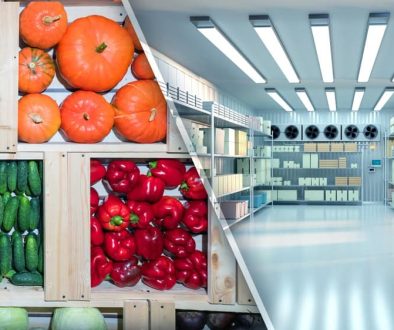Sustainable refrigeration in supermarkets: technologies, strategies and perspectives
In recent years, thanks to regulatory, economic and environmental pressures, the issue of sustainable refrigeration in supermarkets has emerged as a strategic priority. In is not only a question of reducing the environmental impact but also of:
- optimising costs;
- protecting against future regulatory risk;
- and increasing competitivity by building the company’s reputation for environmental responsibility.
As well as playing a key role in the economy and in people’s everyday lives, food distribution and retail is one of the most energy and climate intensive sectors.
One of the most critical factors is refrigeration, which indispensable to ensure correct product storage but also one of the leading sources of direct and indirect greenhouse gas emissions.
In supermarkets for example, up to 70% of Scope 1 and Scope 2 emissions can be attributed to cooling systems, due to their elevated electricity consumption and still widespread use of synthetic, high climate altering potential refrigerants.
The impact of refrigeration on climate
As mentioned above, emissions associated with supermarket refrigeration systems can be divided into two categories:
- direct emissions deriving from refrigeration gases lost during operations, maintenance or breakdowns. Hydrofluorocarbons (HFCs), which are still widely used, have a global warming potential (GWP) many times higher than that of CO₂;
- indirect emissions generated by the electricity consumption required to power cooling systems. In mid- to large-sized supermarkets, these systems can account for over half of total energy consumption.
It should be noted that emissions caused by the use of synthetic refrigerants currently exceed the total emissions of the entire civil aviation sector, making this an even more urgent issue.
Increasing regulatory pressure should also be taken into acccount. In Europe, F-gas regulations impose the gradual reduction in the use of HFCs, culminating in an almost complete phase-out by 2030, which is driving the sector to find alternative solutions.
At the same time, the cost of hydrofluorocarbons has risen drastically (over +800% in a few years). This has made their continued use unsustainable in economic terms.
Towards sustainable refrigeration in supermarkets: technological solutions
The route to the decarbonisation of cooling systems is based on a combination of technological, management and organisational choices:
- Natural refrigerants
The most promising alternatives to HFCs are natural refrigerants, which include:
- carbon dioxide (CO₂, R-744): already widely used in European supermarkets, it presents almost zero emissions and ensures optimal efficiency in temperate and cold climates;
- propane (R-290): a highly efficient refrigerant with an almost zero GWP, especially recommended for low power systems such as plug-in fridge cabinets;
- ammonia (NH3, R-717): used mainly in industrial plants and distribution centres, it offers excellent efficiency but requires specific safety measures.
The implementation of these technologies brings many benefits, including greatly reduced direct emissions, improved energy efficiency and a reduction in the time required to recoup the initial investment of between four and ten years.
- Energy efficiency and heat recovery
In addition to the choice of refrigerant, improving energy efficiency is also crucial. Some key measures include:
- the installation of doors on refrigerator cabinets, which can reduce energy consumption by up to 40%;
- the recovery of heat produced by cooling systems to use for internal heating or hot water production;
- integration with renewable sources, such as photovoltaic panels on supermarket rooves, to power refrigeration systems;
- monitoring and smart control systems, which optimise performance in real time, reducing waste and breakdowns.
- Digitalisation and predictive maintenance
Technological advances have made available advanced tools for remote monitoring and predictive plant management. IoT sensors and artificial intelligence algorithms permit the detection of anomalies, the prevention of refrigerant loss and the optimisation of operational cycles. This translates into lower operating costs, greater reliability and further emission reductions.
Operational strategies for retailers and related advantages
In order to make the transition to sustainable refrigeration in supermarkets a reality, companies that manage them must adopt some clear, quantifiable strategies. In its report ‘Cooling the Climate Crisis’, the Environmental Investigation Agency (EIA) set out some interesting guidelines on this, as listed below:
- data transparency: making data on energy consumption, emissions and decarbonisation strategies public not only increases a company’s credibility in the eyes of consumers and investors, also enabling sector benchmarks to be established;
- stop to new HFC installations: immediately blocking every new installation that uses HFCs is essential to avoid technological lock-ins and reduce future conversion costs;
- involvement of the supply chain: sustainability must expand beyond retail outlets, to include distribution centres and logistics. A completely HFC free infrastructure enables overall emissions to be further reduced;
- training and awareness: technicians, maintenance engineers and operational staff must be adequately trained in the new technologies and the correct procedures for natural refrigeration management.
The Agency predicts that by adopting these guidelines, supermarket managers will be able to benefit from a range of advantages, above and beyond compliance with the requirements of the new regulations.
First of all, more efficient systems mean lower energy consumption, a particularly relevant aspect in the current scenario of energy price volatility. By preparing to meet the new regulatory requirements in good time, companies will be able to avoid penalties, unplanned costs and future difficulties.
It is also important to understand that sustainability is now plays a key role in forming consumer opinion as they are increasingly interested in a company’s environmental policies. Greater awareness of this will bring a competitive advantage.
It has also been demonstrated that supermarket chains who implement low environmental impact solutions are viewed more favourably in terms of ESG funding or by stakeholders with a focus on social responsibility. In practice, this means that it will be easier to attract investors.
The experiences of large European retailers show that the transition is possible. The introduction of natural refrigerants, combined with energy efficiency and digitalisation, is the way forward in order to reach climate neutrality targets.
Translated by Joanne Beckwith







